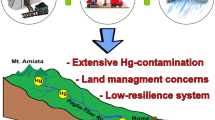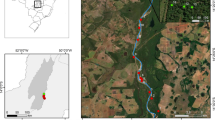Abstract
Mercury (Hg) is a trace element with high toxicological impact on potential receptors, including human beings. Global Hg emissions are predicted to increase significantly during the next 40 years. After emission, the metal is transported by air currents and precipitations, leading to increasing depositions even in areas far from emission sources. In the terrestrial environment, Hg is subjected to redistribution and transformation into different inorganic and metal–organic species that are taken up by vegetation and soil organisms. In the present study, the woodlouse (Porcellio scaber) was used as a biological indicator of total Hg pollution in the city of Dornbirn (province of Vorarlberg), Austria. Woodlice were collected from 30 sampling points scattered over the city area, 25 of them situated within a rectangular transect crossing the city area from west-northwest to east-southeast, starting near the Rheintal motorway and ending at the slopes of the Bregenzer Wald hills. In addition to woodlice, soil substrate samples were collected at nine of the selected sampling points. Total Hg concentrations were measured in isopod tissues and soil substrate samples by means of an Hg analyzer. Total Hg concentrations in isopod tissues were significantly correlated with Hg soil contents (P < 0.05). Moreover, a gradient of increasing Hg concentrations was observed in isopod samples along the transect across Dornbirn, with the lowest concentrations detected in woodlouse samples near the Rheintal motorway and the highest levels toward the ascending slopes of the Bregenzer Wald hills. This gradient of increasing Hg concentrations across the city matches a concomitant increase in wet precipitations along the same direction, indicating that deposition by wet precipitation may be an important source for Hg contamination in the city of Dornbirn. Overall, the degree of Hg contamination across the study area can be regarded as rather low, i.e., comparable with concentrations observed in other, unpolluted terrestrial habitats. It is concluded that bioindication by total Hg analysis in woodlice can be applied to distinguish between different levels and sources of contamination in urban areas.




Similar content being viewed by others
References
Barkay T, Wagner-Döbler I (2005) Microbial transformations of mercury: potentials, challenges, and achievements in controlling mercury toxicity in the environment. Adv Appl Microbiol 57:1–52
Beeby A (2001) What do sentinels stand for? Environ Pollut 112(2):285–298
Berger B, Dallinger R (1993) Terrestrial snails as quantitative indicators of environmental metal pollution. Environ Monit Assess 25:65–84
Blanuš M, Mrković-Milić R, Durbešić P (2002) Lead and cadmium in soil and isopoda woodlice in Croatia. Ecotoxicol Environ Saf 52(3):198–202
Boening DW (2000) Ecological effects, transport, and fate of mercury: a general review. Chemosphere 40:1335–1351
Brereton JLG (1957) The distribution of woodland isopods. Oikos 8(11):85–106
Cortet J, Gomot-De Vaufleury A, Poinsot-Balaguer N, Gomot L, Texier C, Cluzeau D (1999) The use of invertebrate soil fauna in monitoring pollutant effects. Eur J Soil Biol 35(3):115–134
Cristol DA, Brasso RL, Condon AM, Fovargue RE, Freidman SL, Hallinger KK et al (2008) The movement of aquatic mercury through terrestrial food webs. Science 320:335
Dallinger R (1993) Strategies of metal detoxification in terrestrial invertebrates. In: Dallinger R, Rainbow PS (eds) Ecotoxicology of metals in invertebrates. Lewis, Boca Raton, pp 245–289
Dallinger R (1994) Invertebrate organisms as biological indicators of heavy metal pollution. Appl Biochem Biotechnol 48:27–31
Dallinger R, Berger B (1992) Bio-monitoring in the urban environment. In: Bonotto S, Nobili R, Revoltella RP (eds) Biological indicators for environmental monitoring. Serono Sympsia Review No. 27, Rome, pp 227–242
Dallinger R, Berger B, Birkel S (1992) Terrestrial isopods: useful biological indicators of urban metal pollution. Oecologia 89:32–41
De Vries W, Römkens PF, Schütze G (2007) Critical soil concentrations of cadmium, lead, and mercury in view of health effects on humans and animals. Rev Environ Contam Toxicol 191:91–130
Engelhard C, De Toffol S, Lek I, Rauch W, Dallinger R (2007) Environmental impacts of urban snow management: the alpine case study of Innsbruck. Sci Total Environ 382:286–294
Gál J, Markiewicz-Patkowska J, Hursthouse A, Tatner P (2008) Metal uptake by woodlice in urban soils. Ecotoxicol Environ Saf 69(1):139–149
Gerdol R, Bragazza L, Marchesini R, Alber R, Bonetti L, Lorenzoni G et al (2000) Monitoring of heavy metal deposition in Northern Italy by moss analysis. Environ Pollut 108(2):201–208
Giurginca A, Murariu A, Giurginca M (2008) Potentially toxic metals in the Oniscoidea and Diplopoda from Bucharest. In: Makarov SE, Dimitrijevic RN (eds) Advances in arachnology and developmental biology. Vienna – Belgrade – Sophia Monographs, vol 12, pp 201–207
Gnamuš A, Burne A, Horvat M (2000) Mercury in the soil-plant-deer-predator food chain of a temperate forest in Slovenia. Environ Sci Technol 34:3337–3345
Gundacker C, Pietschnig B, Wittmann KJ, Lischka A, Salzer H, Hohenauer L et al (2002) Lead and mercury in breast milk. Pediatrics 110(5):873–878
Heikens A, Peijnenburg WJ, Hendriks AJ (2001) Bioaccumulation of heavy metals in terrestrial invertebrates. Environ Pollut 113(3):385–393
Hendrickx F, Maelfait J-P, De Mayer A, Tack FMG, Verloo MG (2003) Storage mediums affect metal concentrations in woodlice (Isopoda). Environ Pollut 121(1):87–93
Hilson G, Hilson CJ, Pardie S (2007) Improving awareness of mercury pollution in small-scale gold mining communities: challenges and ways forward in rural Ghana. Environ Res 103:275–287
Hopkin SP (1989) Ecophysiology of metals in terrestrial invertebrates. Elsevier, London
Hopkin SP (1990) Species-specific differences in the net assimilation of zinc, cadmium, lead, copper and iron by the terrestrial isopods Oniscus asellus and Porcellio scaber. J Appl Ecol 27:460–474
Hopkin SP, Hardisty GN, Martin MH (1986) The woodlouse Porcellio scaber as a “biological indicator” of zinc, cadmium, lead and copper pollution. Environ Pollut Ser B 11(4):271–290
Hopkin SP, Jones DT, Dietrich D (1993) The isopod Porcellio scaber as a monitor of the bioavailability of metals in terrestrial ecosystems: towards a global “woodlouse watch” scheme. Sci Total Environ 134(1):357–365
Hylander LD, Goodsite ME (2006) Environmental costs of mercury pollution. Sci Total Environ 368:352–370
Jereb V, Horvat M, Drobne D, Pihlar B (2003) Transformations of mercury in the terrestrial isopod Porcellio scaber (Crustacea). Sci Total Environ 304:269–284
Koch E, Werner R (2001) Wind. In: Amt der Vorarlberger Landesregierung (ed) Klima von Vorarlberg. Amt der Vorarlberger Landesregierung, Bregenz, pp 318
Landis MS, Lewis CW, Stevens RK, Keeler GJ (2007) Mt. McHenry tunnel study: source profiles and mercury emissions from diesel and gasoline powered vehicles. Atmos Environ 41:8711–8724
Lapanje A, Drobne D, Nolde N, Valant J, Muscet B, Leser V et al (2008) Long-term Hg pollution induced Hg tolerance in the terrestrial isopod Porcellio scaber (Isopoda, Crustacea). Environ Pollut 153:537–547
Lapanje A, Zrimec A, Drobne D, Rupnik M (2010) Long-term Hg pollution-induced structural shifts of bacterial community in the terrestrial isopod (Porcellio scaber) gut. Environ Pollut 158:3186–3193
Lindqvist L, Block M, Tjalve H (1995) Distribution and excretion of Cd, Hg, methyl-Hg and Zn in the predatory beetle Pterostichus niger. Environ Toxicol Chem 14:1195–1201
Liu Y-R, Zheng Y-M, Zhang L-M, Luan Y-X, He J-Z (2010) Effects of mercury on reproduction, avoidance, and heat shock protein gene expression of the soil springtail Folsomia candida. Environ Toxicol Chem 29(3):654–659
Lock K, Janssen C (2001) Ecotoxicity of mercury to Eisenia fetida, Enchytraeus albidus and Folsomia candida. Biol Fertil Soils 34(4):219–221
Markus JA, McBratney AB (1996) An urban soil study: heavy metals in Glebe, Australia. Austr J Soil Res 34(3):453–465
Meili M, Bishop K, Bringmark L, Johansson K, Munthe J, Sverdrup H et al (2003) Critical levels of atmospheric pollution: criteria and concepts for operational modeling of mercury in forest and lake ecosystems. Sci Total Environ 304:83–106
Miller EK, Vanarsdale A, Keeler GJ, Chalmers A, Poissant L, Kamman NC et al (2005) Estimation and mapping of wet and dry mercury deposition across Northeastern North America. Ecotoxicology 14(1–2):53–57
Mukherjee AB, Zevenhoven R, Brodersen J, Hylander LD, Bhattacharya P (2004) Mercury in waste in the European Union: sources, disposal methods and risks. Res Conserv Recycl 42:155–182
Nolde N, Drobne D, Horvat M, Jereb V (2005) Reduction and methylation of mercury in the terrestrial isopod Porcellio scaber (Crustacea) and its environment. Environ Toxicol Chem 24(7):1697–1704
Nolde N, Drobne D, Valant J, Padovan I, Horvat M (2006) Lysosomal membrane stability in laboratory- and field-exposed terrestrial isopods Porcellio scaber (Isopoda, Crustacea). Environ Toxicol Chem 25(8):2114–2122
Pacyna EG, Pacyna JM (2002) Global emission of mercury from anthropogenic sources in 1995. Water Air Soil Pollut 137(1–4):149–165
Pacyna JM, Pacyna EG, Aas W (2009) Changes of emissions and atmospheric deposition of mercury, lead, and cadmium. Atmos Environ 43:117–127
Paoletti MG, Hassall M (1999) Woodlice (Isopoda: Oniscidea): their potential for assessing sustainability and use as bioindicators. Agr Ecosyst Environ 74:157–165
Prosi F, Dallinger R (1988) Heavy metals in the terrestrial isopod Porcellio scaber Latreille. I. Histochemical and ultrastructural characterization of metal containing lysosomes. Cell Biol Toxicol 4(1):81–96
Sager M, Reichel G, Grüner M, Würzner H (1997) Quecksilbergehalte von Futtermittelproben in Österreich. Die Bodenkultur 48:23–32
Sandoval MC, Veiga M, Hinton J, Klein B (2001) Review of biological indicators for metal mining effluents: a proposed protocol using earthworms. Proceedings of the 25th annual British Columbia reclamation symposium, Campbell River, 23–27 September, pp 67–79
Schilling JS, Lehman ME (2002) Bioindication of atmospheric heavy metal deposition in the Southeastern US using the moss Thuidium delicatulum. Atmos Environ 36(10):1611–1618
Schwesig D, Matzner E (2000) Pools and fluxes of mercury and methylmercury in two forested catchments in Germany. Sci Total Environ 260:213–223
Slabber S, Chown S (2002) The first record of a terrestrial crustacean, Porcellio scaber (Isopoda, Porcellionidae), from sub-Antarctic Marion Island. Polar Biol 25(11):855–858
Steinnes E, Anderssor EM (1991) Atmospheric deposition of mercury in Norway: temporal and spatial trends. Water Air Soil Pollut 56(1):391–404
Streets DG, Zhang Q, Wu Y (2009) Projections of global mercury emissions in 2050. Environ Sci Technol 43:2983–2988
Talmage SS, Walton BT (1993) Food chain transfer and potential renal toxicity of mercury to small mammals at a contaminated terrestrial field site. Ecotoxicology 2(4):243–256
Udovic M, Drobne D, Lestan D (2009) Bioaccumulation in Porcellio scaber (Crustacea, Isopoda) as a measure of the EDTA remediation efficiency of metal-polluted soil. Environ Pollut 157(10):2822–2829
Van Straalen NM (1998) Evaluation of bioindicator systems derived from soil arthropod communities. Appl Soil Ecol 9(1–3):429–437
Vermeulen Van, den Brink NW, D`Havé H, Mubiana VK, Blust R, Bervoets L et al (2009) Habitat type-based bioaccumulation and risk assessment of metal and As contamination in earthworms, beetles and woodlice. Environ Pollut 157(11):3098–3105
Vilisics F, Elek Z, Lövei G, Hornung E (2007) Composition of terrestrial isopod assemblages along an urbanisation gradient in Denmark. Pedobiologia 51(1):45–53
Wang D, Shi X, Wei S (2003) Accumulation and transformation of atmospheric mercury in soil. Sci Total Environ 304(1–3):209–214
Werner R (2011) Datenextrakt aus dem GIS des Landes Vorarlberg: Niederschlagskarten, Höhenmodell, Verkehr, Siedlungszone. Amt der Vorarlberger Landesregierung, Bregenz
Whitfield J (2001) Vital signs. Nature 411:989–990
Wiener JG, Knights BC, Sandheinrich MB, Jeremiason JD, Brigham ME, Engstrom DR et al (2006) Mercury in soils, lakes, and fish in Voyageurs National Park (Minnesota): importance of atmospheric deposition and ecosystem factors. Environ Sci Technol 40:6261–6268
Wieser W, Dallinger R, Busch G (1977) The flow of copper through a terrestrial food chain. II. Factors influencing the copper content of isopods. Oecologia 30:265–272
Witzel B (2000) The influence of zinc on the uptake and loss of cadmium and lead in the woodlouse, Porcellio scaber (Isopoda, Oniscidea). Ecotoxicol Environ Saf 47(1):43–53
Wu Y, Wang S, Streets DG, Hao J, Chan M, Jiang J (2006) Trends in anthropogenic mercury emissions in China from 1995 to 2003. Environ Sci Technol 40:5312–5318
Zechmeister HG (1995) Correlation between altitude and heavy metal deposition in the Alps. Environ Pollut 89(1):73–80
Acknowledgments
This study was funded by a grant from Inatura-Erlebnis Naturschau GmbH, Dornbirn (Vorarlberg, Austria) and co-financed by a project of the Austrian Science Foundation (Project No. P 19782-B03) to R. D. We thank Margit Schmid (inatura Dornbirn) for support and Frieda Tataruch (University of Vienna, Austria) for helpful discussion.
Author information
Authors and Affiliations
Corresponding author
Rights and permissions
About this article
Cite this article
Pedrini-Martha, V., Sager, M., Werner, R. et al. Patterns of Urban Mercury Contamination Detected by Bioindication With Terrestrial Isopods. Arch Environ Contam Toxicol 63, 209–219 (2012). https://doi.org/10.1007/s00244-012-9766-3
Received:
Accepted:
Published:
Issue Date:
DOI: https://doi.org/10.1007/s00244-012-9766-3




